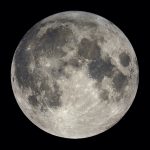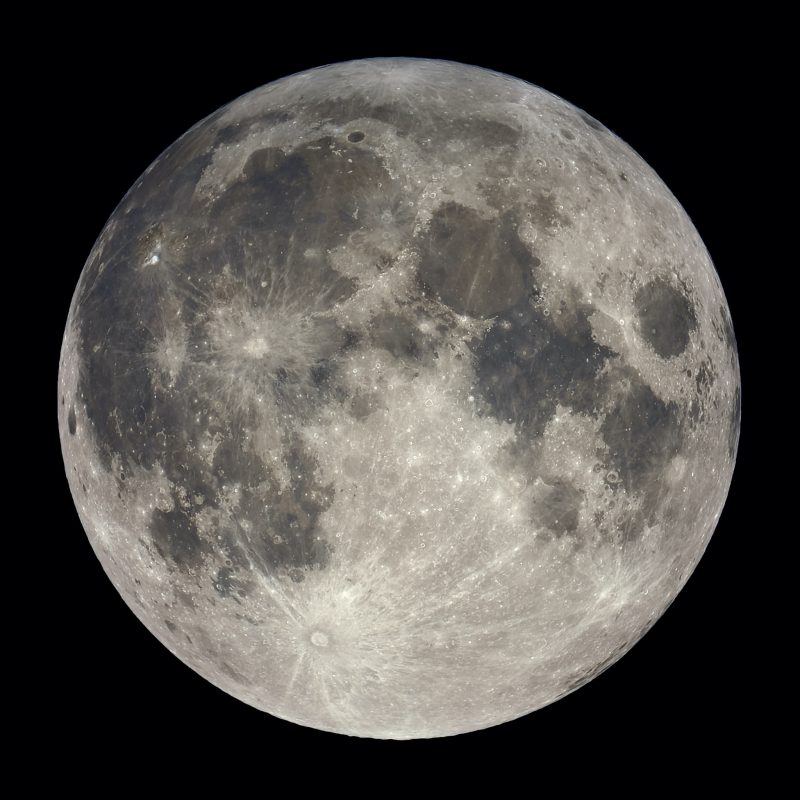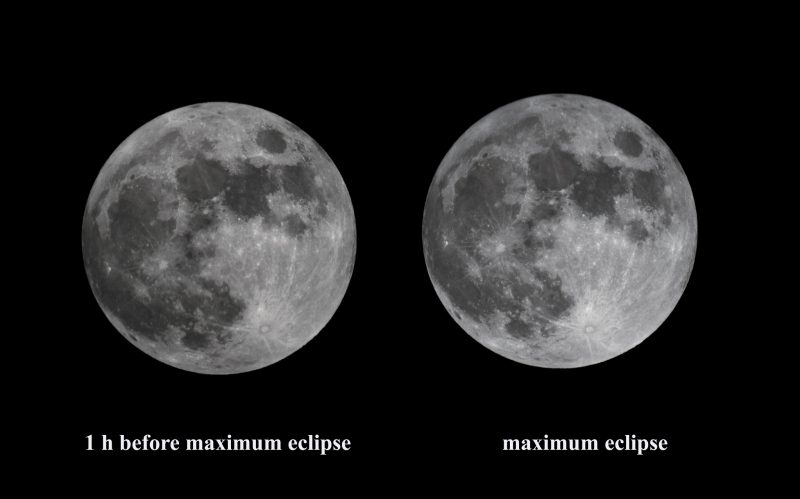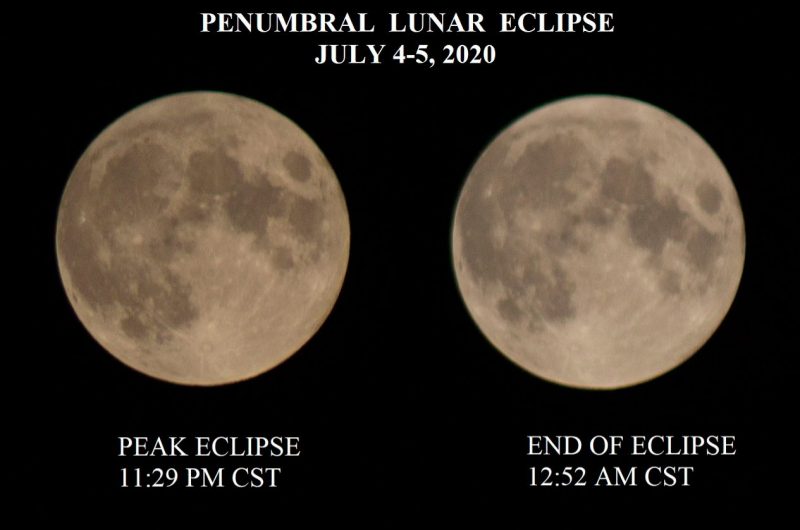

View at EarthSky Community Photos. | Rob Pettengill in Austin, Texas – an experienced moon photographer – caught this image of the full moon Saturday night, July 4, 2020, one minute before midnight, at the height of the partial penumbral eclipse. He wrote: “A beautiful full moon for Independence Day in the United States, but where did the eclipse go? Partial penumbral eclipses are very subtle. Only a small sliver of the sun is hidden by the Earth, in roughly the top third of this image. This small gradual change in illumination is almost impossible to detect without careful photometric measurement.” Thanks, Rob!
By all reports, the faint partial penumbral lunar eclipse of July 4-5, 2020 was barely discernible (if that), even by experienced observers. At maximum eclipse, only about a third of the moon was covered by Earth’s faint, outer penumbral shadow. And – for most of us – that’s not enough to make the eclipse visible, according to experts.
For example, prior to July 4, eclipse guru Fred Espenak had written at the Facebook group Solar Eclipse Chasers:
During past lunar eclipses, I have made a concerted effort to determine when I can first see the subtle shading of Earth’s penumbral shadow on the moon (using unaided eye and binoculars). I have consistently found the penumbral shading is only detectable when at least 2/3 of the moon lies within the penumbral shadow.
Since the moon will only pass 1/3 of the way into the penumbral shadow during the July 4/5 lunar eclipse, it will not be visible to the unaided eye. But digital photography can reveal the subtle shading if the contrast of the image is greatly increased.
On the other hand, it’s been my experience that people’s powers of observation vary greatly. Some people have exceptional eyesight. Some have a really remarkable ability to notice subtle details. If that’s you, and you noticed Earth’s shadow on the moon during this eclipse, let us know in the comments below!

Eliot Herman in Tucson, Arizona – another experienced sky photographer – told EarthSky: “The eclipse was mostly a bust, but I do think there was a slight shadow. This is a side-by-side comparison of the moon one hour before, and at, maximum eclipse. There appears to be a very slight shading in the north of the moon as expected by prediction. These images were acquired in Tucson under somewhat degraded seeing from the Bighorn fire smoke particles still in the sky. The capture equipment is a Questar telescope and a Nikon D850. The exposures were matched closely as possible and the imagery was processed as a duo unit as to be identical.” Thank you, Eliot!

View at EarthSky Community Photos. | Iqbal Khan in Columbia, Missouri wrote: “A subtle penumbral lunar eclipse.” Thank you, Iqbal!
Bottom line: Even experienced observers say they couldn’t discern the Earth’s shadow on the moon during the partial penumbral eclipse of July 4-5, 2020. Did you see it? Do your photos show it? Let us know in the comments below, or post at EarthSky Community Photos.
from EarthSky https://ift.tt/2AuVw0y


View at EarthSky Community Photos. | Rob Pettengill in Austin, Texas – an experienced moon photographer – caught this image of the full moon Saturday night, July 4, 2020, one minute before midnight, at the height of the partial penumbral eclipse. He wrote: “A beautiful full moon for Independence Day in the United States, but where did the eclipse go? Partial penumbral eclipses are very subtle. Only a small sliver of the sun is hidden by the Earth, in roughly the top third of this image. This small gradual change in illumination is almost impossible to detect without careful photometric measurement.” Thanks, Rob!
By all reports, the faint partial penumbral lunar eclipse of July 4-5, 2020 was barely discernible (if that), even by experienced observers. At maximum eclipse, only about a third of the moon was covered by Earth’s faint, outer penumbral shadow. And – for most of us – that’s not enough to make the eclipse visible, according to experts.
For example, prior to July 4, eclipse guru Fred Espenak had written at the Facebook group Solar Eclipse Chasers:
During past lunar eclipses, I have made a concerted effort to determine when I can first see the subtle shading of Earth’s penumbral shadow on the moon (using unaided eye and binoculars). I have consistently found the penumbral shading is only detectable when at least 2/3 of the moon lies within the penumbral shadow.
Since the moon will only pass 1/3 of the way into the penumbral shadow during the July 4/5 lunar eclipse, it will not be visible to the unaided eye. But digital photography can reveal the subtle shading if the contrast of the image is greatly increased.
On the other hand, it’s been my experience that people’s powers of observation vary greatly. Some people have exceptional eyesight. Some have a really remarkable ability to notice subtle details. If that’s you, and you noticed Earth’s shadow on the moon during this eclipse, let us know in the comments below!

Eliot Herman in Tucson, Arizona – another experienced sky photographer – told EarthSky: “The eclipse was mostly a bust, but I do think there was a slight shadow. This is a side-by-side comparison of the moon one hour before, and at, maximum eclipse. There appears to be a very slight shading in the north of the moon as expected by prediction. These images were acquired in Tucson under somewhat degraded seeing from the Bighorn fire smoke particles still in the sky. The capture equipment is a Questar telescope and a Nikon D850. The exposures were matched closely as possible and the imagery was processed as a duo unit as to be identical.” Thank you, Eliot!

View at EarthSky Community Photos. | Iqbal Khan in Columbia, Missouri wrote: “A subtle penumbral lunar eclipse.” Thank you, Iqbal!
Bottom line: Even experienced observers say they couldn’t discern the Earth’s shadow on the moon during the partial penumbral eclipse of July 4-5, 2020. Did you see it? Do your photos show it? Let us know in the comments below, or post at EarthSky Community Photos.
from EarthSky https://ift.tt/2AuVw0y

Aucun commentaire:
Enregistrer un commentaire